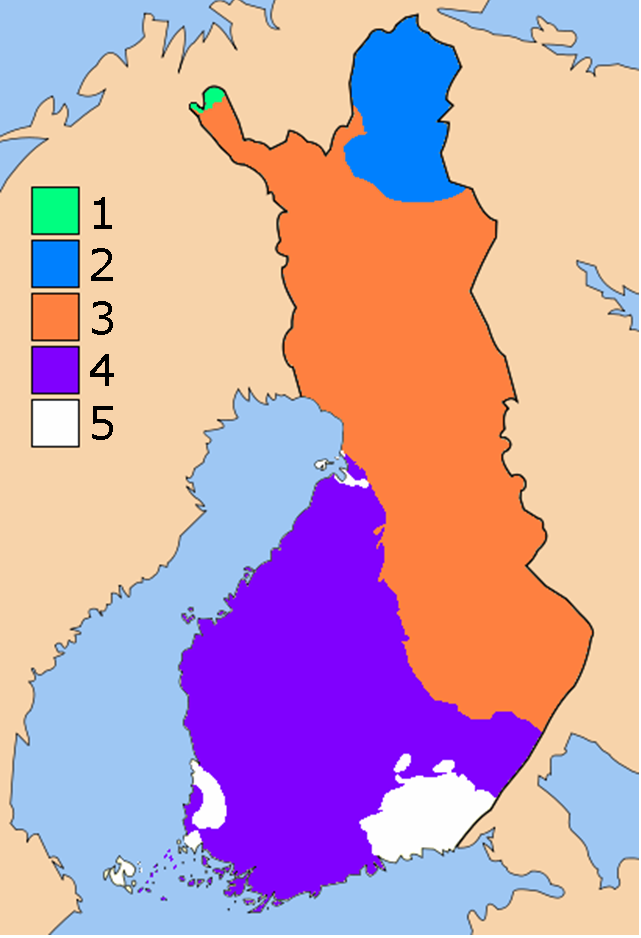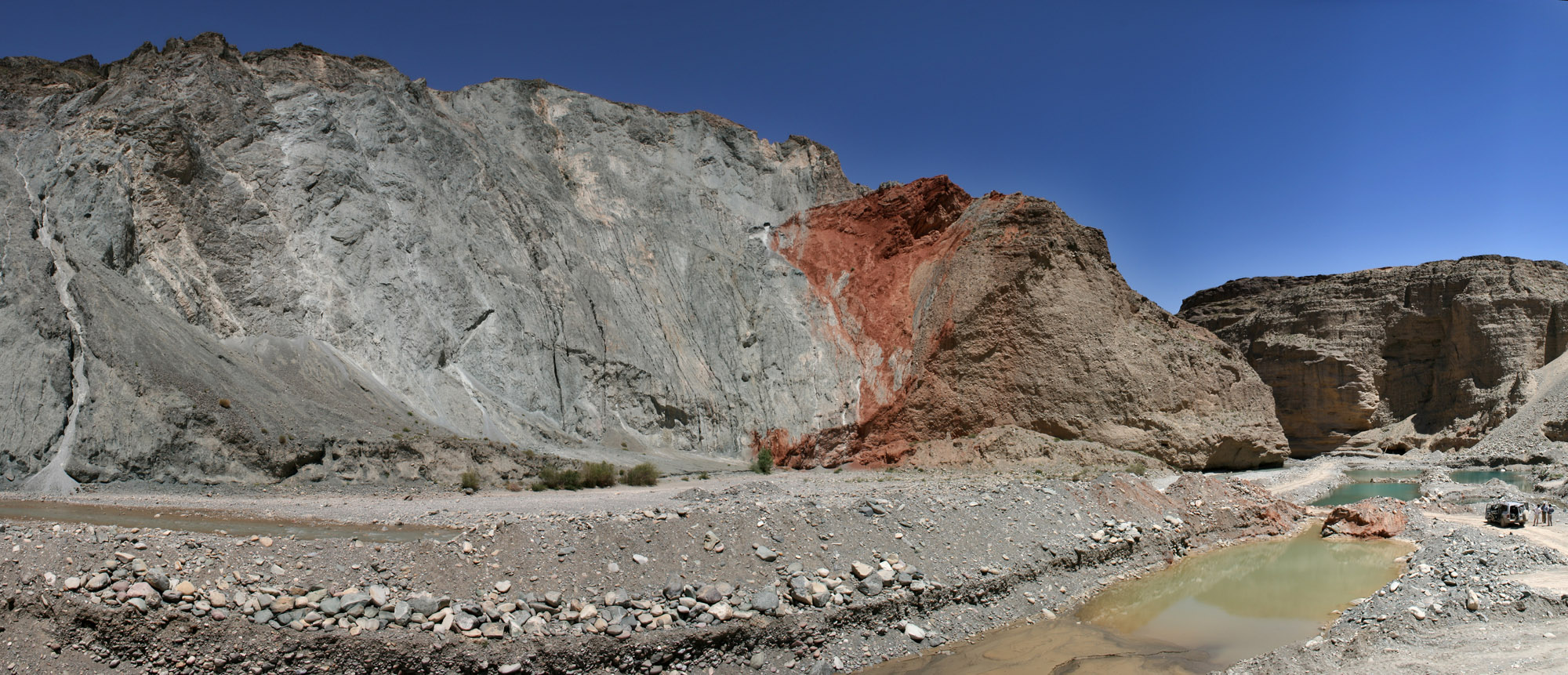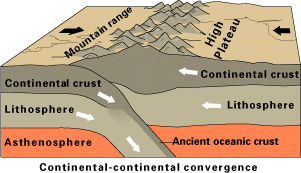|
Lapland Granulite Belt
The Lapland Granulite Belt is an elongate and arcuate zone of granulite rock in the Cap of the North spanning areas within Norway, Finland and Murmansk Oblast in Russia. At most the belt is 80 km broad. The main rocks of the belt are migmatized greywacke and argillites. Studies of detrital zircon show that the sedimentary protolith of the metamorphic rocks of the belt could not be older than 2900–1940 million years. The belt has norite and enderbite intrusions of calc-alkaline chemistry. It is believed that the belt formed by the closure of an ancient Lapland-Kola Ocean and the continental collision of two continents of Archean age. The granulite belt with its arcuate shape is part of the larger Inari orocline An orocline — from the Greek words for "mountain" and "to bend" — is a bend or curvature of an orogenic (mountain building) belt imposed after it was formed. The term was introduced by S. Warren Carey in 1955 in a paper setting forth how comp .... This or ... [...More Info...] [...Related Items...] OR: [Wikipedia] [Google] [Baidu] |
Bedrock Of Finland
In geology, bedrock is solid Rock (geology), rock that lies under loose material (regolith) within the crust (geology), crust of Earth or another terrestrial planet. Definition Bedrock is the solid rock that underlies looser surface material. An exposed portion of bedrock is often called an outcrop. The various kinds of broken and weathered rock material, such as soil and subsoil, that may overlie the bedrock are known as regolith. Engineering geology The surface of the bedrock beneath the soil cover (regolith) is also known as ''rockhead'' in engineering geology, and its identification by digging, drilling or geophysics, geophysical methods is an important task in most civil engineering projects. Superficial deposition (geology), deposits can be very thick, such that the bedrock lies hundreds of meters below the surface. Weathering of bedrock Exposed bedrock experiences weathering, which may be physical or chemical, and which alters the structure of the rock to leave ... [...More Info...] [...Related Items...] OR: [Wikipedia] [Google] [Baidu] |
Million Years Ago
The abbreviation Myr, "million years", is a unit of a quantity of (i.e. ) years, or 31.556926 teraseconds. Usage Myr (million years) is in common use in fields such as Earth science and cosmology. Myr is also used with Mya (million years ago). Together they make a reference system, one to a quantity, the other to a particular place in a year numbering system that is ''time before the present''. Myr is deprecated in geology, but in astronomy ''Myr'' is standard. Where "myr" ''is'' seen in geology it is usually "Myr" (a unit of mega-years). In astronomy it is usually "Myr" (Million years). Debate In geology a debate remains open concerning the use of ''Myr'' (duration) plus ''Ma'' (million years ago) versus using only the term ''Ma''. In either case the term '' Ma'' is used in geology literature conforming to ISO 31-1 (now ISO 80000-3) and NIST 811 recommended practices. Traditional style geology literature is written The "ago" is implied, so that any such year number "X Ma" ... [...More Info...] [...Related Items...] OR: [Wikipedia] [Google] [Baidu] |
Geology Of European Russia
Geology () is a branch of natural science concerned with Earth and other astronomical objects, the features or rocks of which it is composed, and the processes by which they change over time. Modern geology significantly overlaps all other Earth sciences, including hydrology, and so is treated as one major aspect of integrated Earth system science and planetary science. Geology describes the structure of the Earth on and beneath its surface, and the processes that have shaped that structure. It also provides tools to determine the relative and absolute ages of rocks found in a given location, and also to describe the histories of those rocks. By combining these tools, geologists are able to chronicle the geological history of the Earth as a whole, and also to demonstrate the age of the Earth. Geology provides the primary evidence for plate tectonics, the evolutionary history of life, and the Earth's past climates. Geologists broadly study the properties and processes of Ear ... [...More Info...] [...Related Items...] OR: [Wikipedia] [Google] [Baidu] |
Thrust Fault
A thrust fault is a break in the Earth's crust, across which older rocks are pushed above younger rocks. Thrust geometry and nomenclature Reverse faults A thrust fault is a type of reverse fault that has a dip of 45 degrees or less. If the angle of the fault plane is lower (often less than 15 degrees from the horizontal) and the displacement of the overlying block is large (often in the kilometer range) the fault is called an ''overthrust'' or ''overthrust fault''. Erosion can remove part of the overlying block, creating a ''fenster'' (or ''window'') – when the underlying block is exposed only in a relatively small area. When erosion removes most of the overlying block, leaving island-like remnants resting on the lower block, the remnants are called ''klippen'' (singular ''klippe''). Blind thrust faults If the fault plane terminates before it reaches the Earth's surface, it is referred to as a ''blind thrust'' fault. Because of the lack of surface evidence, blind thr ... [...More Info...] [...Related Items...] OR: [Wikipedia] [Google] [Baidu] |
Orocline
An orocline — from the Greek words for "mountain" and "to bend" — is a bend or curvature of an orogenic (mountain building) belt imposed after it was formed. The term was introduced by S. Warren Carey in 1955 in a paper setting forth how complex shapes of various orogenic belts could be explained by actual bending, and that understanding this provided "the key to understanding the evolution of the continents". Carey showed that in a dozen cases where such bends were undone the results were substantially identical with continental reconstructions deduced by other means.. Recognition of oroclinal bending provided strong support to the subsequent theory of plate tectonics. Examples *The Bolivian Orocline is a seaward concave bending in the coast of South America and the Andes mountains at about 18° S. At this point the orientation of the Andes turns from Northwest in Peru to South in Chile and Argentina. The Andean segment north and south of the orocline have been rotated 15° t ... [...More Info...] [...Related Items...] OR: [Wikipedia] [Google] [Baidu] |
Studentlitteratur
Studentlitteratur is an academic publishing company based in Sweden and publishing mostly in Swedish. It is one of the largest producers of university text books and course books in Sweden. The company was established in 1963 and is based in the university city of Lund Lund (, , ) is a city in the southern Swedish provinces of Sweden, province of Scania, across the Øresund, Öresund strait from Copenhagen. The town had 91,940 inhabitants out of a municipal total of 121,510 . It is the seat of Lund Municipali .... References External links *'Official website'' Book publishing company imprints Book publishing companies of Sweden Mass media in Lund Publishing companies established in 1963 1963 establishments in Sweden Companies based in Lund 20th-century establishments in Skåne County {{publish-company-stub ... [...More Info...] [...Related Items...] OR: [Wikipedia] [Google] [Baidu] |
Archean
The Archean Eon ( , also spelled Archaean or Archæan) is the second of four geologic eons of Earth's history, representing the time from . The Archean was preceded by the Hadean Eon and followed by the Proterozoic. The Earth Earth is the third planet from the Sun and the only astronomical object known to harbor life. While large volumes of water can be found throughout the Solar System, only Earth sustains liquid surface water. About 71% of Earth's surfa ... during the Archean was mostly a water world: there was continental crust, but much of it was under an ocean deeper than today's ocean. Except for some trace minerals, today's oldest continental crust dates back to the Archean. Much of the geological detail of the Archean has been destroyed by subsequent activity. The Earliest known life forms, earliest known life started in the Archean. Life was simple throughout the Archean, mostly represented by shallow-water microbial mats called stromatolites, and the a ... [...More Info...] [...Related Items...] OR: [Wikipedia] [Google] [Baidu] |
Continental Collision
In geology, continental collision is a phenomenon of plate tectonics that occurs at convergent boundaries. Continental collision is a variation on the fundamental process of subduction, whereby the subduction zone is destroyed, mountains produced, and two continents sutured together. Continental collision is only known to occur on Earth. Continental collision is not an instantaneous event, but may take several tens of millions of years before the faulting and folding caused by collisions stops. The collision between India and Asia has been going on for about 50 million years already and shows no signs of abating. Collision between East and West Gondwana to form the East African Orogen took about 100 million years from beginning (610 Ma) to end (510 Ma). The collision between Gondwana and Laurasia to form Pangea occurred in a relatively brief interval, about 50 million years long. Subduction zone: the collision site The process begins as two conti ... [...More Info...] [...Related Items...] OR: [Wikipedia] [Google] [Baidu] |
Calc-alkaline Magma Series
The calc-alkaline magma series is one of two main subdivisions of the subalkaline magma series, the other subalkaline magma series being the tholeiitic series. A magma series is a series of compositions that describes the evolution of a mafic magma, which is high in magnesium and iron and produces basalt or gabbro, as it fractionally crystallizes to become a felsic magma, which is low in magnesium and iron and produces rhyolite or granite. Calc-alkaline rocks are rich in alkaline earths ( magnesia and calcium oxide) and alkali metals and make up a major part of the crust of the continents. The diverse rock types in the calc-alkaline series include volcanic types such as basalt, andesite, dacite, rhyolite, and also their coarser-grained intrusive equivalents (gabbro, diorite, granodiorite, and granite). They do not include silica-undersaturated, alkalic, or peralkaline rocks. Geochemical characterization Rocks from the calc-alkaline magma series are distinguished from rocks ... [...More Info...] [...Related Items...] OR: [Wikipedia] [Google] [Baidu] |
Intrusion
In geology, an igneous intrusion (or intrusive body or simply intrusion) is a body of intrusive igneous rock that forms by crystallization of magma slowly cooling below the surface of the Earth. Intrusions have a wide variety of forms and compositions, illustrated by examples like the Palisades Sill of New York and New Jersey; the Henry Mountains of Utah; the Bushveld Igneous Complex of South Africa; Shiprock in New Mexico; the Ardnamurchan intrusion in Scotland; and the Sierra Nevada Batholith of California. Because the solid country rock into which magma intrudes is an excellent insulator, cooling of the magma is extremely slow, and intrusive igneous rock is coarse-grained (phaneritic). Intrusive igneous rocks are classified separately from extrusive igneous rocks, generally on the basis of their mineral content. The relative amounts of quartz, alkali feldspar, plagioclase, and feldspathoid is particularly important in classifying intrusive igneous rocks. Intrusions ... [...More Info...] [...Related Items...] OR: [Wikipedia] [Google] [Baidu] |
Enderbite
In geology, enderbite is an igneous rock of the charnockite series, consisting essentially of quartz, antiperthite (or perthite), orthopyroxene (usually hypersthene) and magnetite, and is equivalent to an orthopyroxene bearing tonalite. It is named for its occurrence in Enderby Land, Antarctica Antarctica () is Earth's southernmost and least-populated continent. Situated almost entirely south of the Antarctic Circle and surrounded by the Southern Ocean, it contains the geographic South Pole. Antarctica is the fifth-largest contine .... References * ''Classification of igneous rocks'', 2nd edition, 2002, by R.W. Le Maitre et al. Plutonic rocks {{petrology-stub ... [...More Info...] [...Related Items...] OR: [Wikipedia] [Google] [Baidu] |
Norite
Norite is a mafic intrusive igneous rock composed largely of the calcium-rich plagioclase labradorite, orthopyroxene, and olivine. The name ''norite'' is derived from ''Norge'', the Norwegian name for Norway. Norite also known as orthopyroxene gabbro. Norite may be essentially indistinguishable from gabbro without thin section study under the petrographic microscope. The principal difference between norite and gabbro is the type of pyroxene of which it is composed. Norite is predominantly composed of orthopyroxenes, largely high magnesian enstatite or an iron bearing intermediate hypersthene. The principal pyroxenes in gabbro are clinopyroxenes, generally medially iron-rich augites. Norite occurs with gabbro and other mafic to ultramafic rocks in layered intrusions which are often associated with platinum orebodies such as in the Bushveld Igneous Complex in South Africa, the Skaergaard igneous complex of Greenland, and the Stillwater igneous complex in Montana. Norite is als ... [...More Info...] [...Related Items...] OR: [Wikipedia] [Google] [Baidu] |








